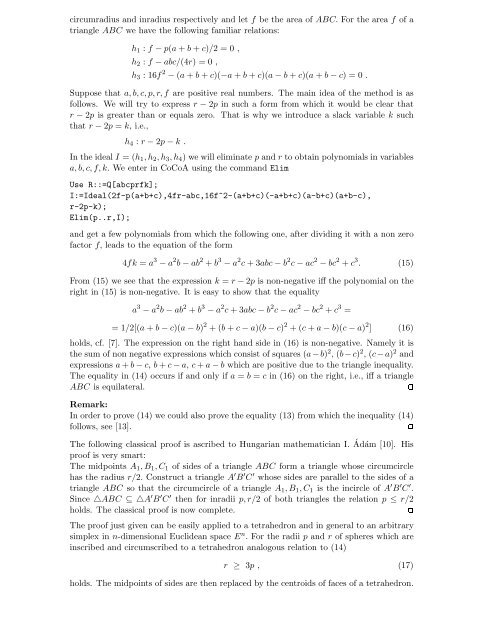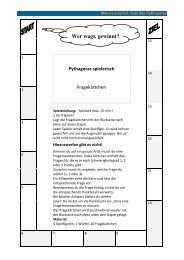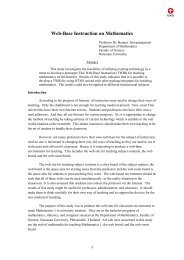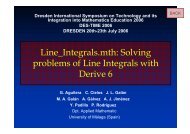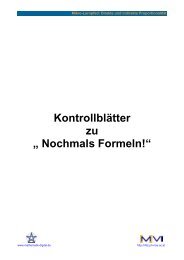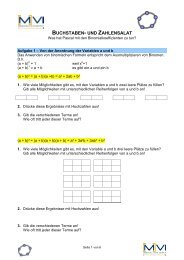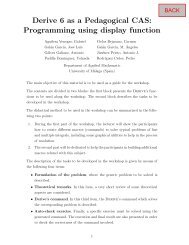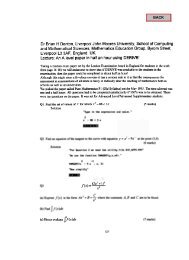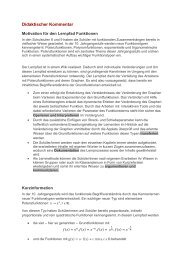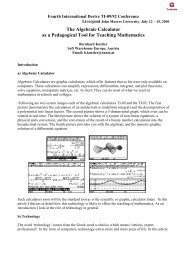Discovering and proving geometric inequalities by CAS (pdf)
Discovering and proving geometric inequalities by CAS (pdf)
Discovering and proving geometric inequalities by CAS (pdf)
You also want an ePaper? Increase the reach of your titles
YUMPU automatically turns print PDFs into web optimized ePapers that Google loves.
circumradius <strong>and</strong> inradius respectively <strong>and</strong> let f be the area of ABC. For the area f of a<br />
triangle ABC we have the following familiar relations:<br />
h1 : f − p(a + b + c)/2 =0,<br />
h2 : f − abc/(4r) =0,<br />
h3 :16f 2 − (a + b + c)(−a + b + c)(a − b + c)(a + b − c) =0.<br />
Suppose that a, b, c, p, r, f are positive real numbers. The main idea of the method is as<br />
follows. We will try to express r − 2p in such a form from which it would be clear that<br />
r − 2p is greater than or equals zero. That is why we introduce a slack variable k such<br />
that r − 2p = k, i.e.,<br />
h4 : r − 2p − k.<br />
In the ideal I =(h1,h2,h3,h4) we will eliminate p <strong>and</strong> r to obtain polynomials in variables<br />
a, b, c, f, k. We enter in CoCoA using the comm<strong>and</strong> Elim<br />
Use R::=Q[abcprfk];<br />
I:=Ideal(2f-p(a+b+c),4fr-abc,16f^2-(a+b+c)(-a+b+c)(a-b+c)(a+b-c),<br />
r-2p-k);<br />
Elim(p..r,I);<br />
<strong>and</strong> get a few polynomials from which the following one, after dividing it with a non zero<br />
factor f, leads to the equation of the form<br />
4fk = a 3 − a 2 b − ab 2 + b 3 − a 2 c +3abc − b 2 c − ac 2 − bc 2 + c 3 . (15)<br />
From (15) we see that the expression k = r − 2p is non-negative iff the polynomial on the<br />
right in (15) is non-negative. It is easy to show that the equality<br />
a 3 − a 2 b − ab 2 + b 3 − a 2 c +3abc − b 2 c − ac 2 − bc 2 + c 3 =<br />
=1/2[(a + b − c)(a − b) 2 +(b + c − a)(b − c) 2 +(c + a − b)(c − a) 2 ] (16)<br />
holds, cf. [7]. The expression on the right h<strong>and</strong> side in (16) is non-negative. Namely it is<br />
the sum of non negative expressions which consist of squares (a − b) 2 , (b − c) 2 , (c − a) 2 <strong>and</strong><br />
expressions a + b − c, b + c − a, c + a − b which are positive due to the triangle inequality.<br />
The equality in (14) occurs if <strong>and</strong> only if a = b = c in (16) on the right, i.e., iff a triangle<br />
ABC is equilateral.<br />
Remark:<br />
In order to prove (14) we could also prove the equality (13) from which the inequality (14)<br />
follows, see [13].<br />
The following classical proof is ascribed to Hungarian mathematician I. Ádám [10]. His<br />
proof is very smart:<br />
The midpoints A1,B1,C1 of sides of a triangle ABC form a triangle whose circumcircle<br />
has the radius r/2. Construct a triangle A ′ B ′ C ′ whose sides are parallel to the sides of a<br />
triangle ABC so that the circumcircle of a triangle A1,B1,C1 is the incircle of A ′ B ′ C ′ .<br />
Since △ABC ⊆△A ′ B ′ C ′ then for inradii p, r/2 of both triangles the relation p ≤ r/2<br />
holds. The classical proof is now complete.<br />
The proof just given can be easily applied to a tetrahedron <strong>and</strong> in general to an arbitrary<br />
simplex in n-dimensional Euclidean space E n . For the radii p <strong>and</strong> r of spheres which are<br />
inscribed <strong>and</strong> circumscribed to a tetrahedron analogous relation to (14)<br />
r ≥ 3p , (17)<br />
holds. The midpoints of sides are then replaced <strong>by</strong> the centroids of faces of a tetrahedron.


